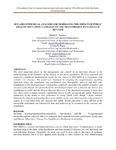| dc.description.abstract | The most important factor in the management and control of an infectious disease is the
understanding of the dynamics of the disease in any given population. We have proposed and
analyzed a nonlinear mathematical model for the spread of HIV/AIDS in a population with
variable size structure. The model was developed by adopting the compartmental modeling
approach where the population was partitioned into; Susceptible, Infected and Aids subpopulations.
A threshold parameter is found that completely determines the stability dynamics and
outcome of the disease. It is found that if the threshold parameter is less than one the disease free
equilibrium is stable and the disease dies out. However, if the threshold parameter is more than
one, there exists a unique endemic equilibrium that is locally asymptotically stable. Numerical
simulation of the model is also performed by using fourth order Runge - Kutta method.
Numerically, it has been found that the system exhibits steady state bifurcation for some parameter
values. It is concluded from our analysis that public health education is more efficient if the
susceptible individuals are educated in time and followed up by treatment in the exposed subpopulation. | en_US |

